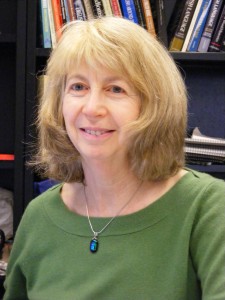In anticipation of the inaugural meeting of the International Network of Language Museums, we spoke with Elaine Gold, Director of the Canadian Language Museum.
For over 20 years, Dr. Gold has taught a variety of courses at the University of Toronto, including Historical Linguistics, Morphology, Sociolinguistics, Languages of Canada, and Canadian English. Here, she speaks with NML Secretary Greg Nedved about language and languages in the Canadian experience.

How did you become involved with the current Canadian Language Museum?
I felt that a country like Canada that has so many indigenous languages, is officially bilingual, and now is home to so many immigrant languages, was calling out for a language museum! I initiated the founding of the Canadian Language Museum at a meeting of the Canadian Linguistics Association in 2011 and took on the roles of Chair and Director at the time.
What is “national” about your museum?
Our museum is national in several ways: through the content of our exhibits and programs, through the reach of our travelling exhibits, and through the makeup of our board. Our goal is to bring information about all the languages of Canada to Canadians. To date we have created five travelling exhibits about the languages of Canada: ‘Canadian English, Eh?’, ‘Le français au Canada’, ‘Speaking the Inuit Way’, ‘Cree: The People’s Language’ and ‘A Tapestry of Voices: Celebrating Canada’s languages!’. All of the museum’s materials – exhibits, website, newsletters, publicity – are in the two official languages of Canada, French and English, so that they are accessible to almost all Canadians.
In order to reach a national audience, we have sent our exhibits across the country. Our exhibits have travelled by car, bus, train, plane and boat to reach viewers from British Columbia on the west coast to Newfoundland in the east, and as far north as James Bay.
We aim to have board members from across the country and representative of the different language communities. Our honorary patron, Tomson Highway, is a well known First Nations playwright and musician, and we have had board members from St. John’s to Vancouver, and from both French and English backgrounds.
What is unique or noteworthy about the Canadian experience with languages?
This is a very big topic! Centuries of push and pull between the French and English on this land have very much shaped today’s Canada. Canada is officially a bilingual country and Canadian cities have become among the most multicultural in the world. Between official bilingualism and Canada’s policy of multiculturalism, I find that Canadians have an openness to and interest in languages other than their own mother tongue.
Over the past decades, Quebec has enacted language laws to protect and promote the French language and this has helped make all Canadians sensitive to the relation between language and culture and to the challenges that minority languages face. The recent report of the Truth and Reconciliation Commission, that was a response to the indigenous people’s experiences in residential schools, has also brought to the public’s attention the dire situation of most of Canada’s indigenous languages. I believe there is a growing interest in indigenous languages and cultures across the country.
How can Canada best save its endangered indigenous languages?
This issue is currently being discussed in indigenous communities and by linguists across the country! It will certainly require community mobilization, coordination among indigenous communities and federal government support. For those languages that are spoken in both the US and Canada, it might mean cross-border cooperation. Above all, it will require parents making the effort to speak their native languages in their homes so that their children can learn them and pass them on to future generations.
What is unique or noteworthy about your museum?
Many language museums around the world focus on a single national language. I think our focus on all of the languages spoken in the country – indigenous, official, immigrant – is unique. I also think our development of small travelling exhibits is noteworthy. We have been able to reach a very wide audience by bringing our exhibits out into the community, rather than waiting for viewers to come to our location.
Where do you want the Canadian Language Museum to be in ten years?
Our goal is that in 10 years the Canadian Language Museum will be an integral part of the museum community in Canada and recognized as the leading centre for information about Canadian languages. We are very fortunate to have recently been given gallery space at Glendon Colllege of York University in Toronto. We hope that the gallery becomes a popular destination and a centre of discussion for language issues that affect all Canadians. We hope too that over the next ten years the Canadian Language Museum will play an important role in the revitalization of indigenous languages.
What has been the most difficult part of keeping your museum running?
As with every arts organization, funding of operations is the biggest challenge!
What advice would you give somebody wanting to start up a language museum?
Have very clear goals: what are you trying to accomplish and who is your intended audience? Base your exhibits on excellent research: search out the experts and include the communities being described. Be realistic about your finances: how are you going to fund your activities now and in the future?
Interview has been edited and condensed.
